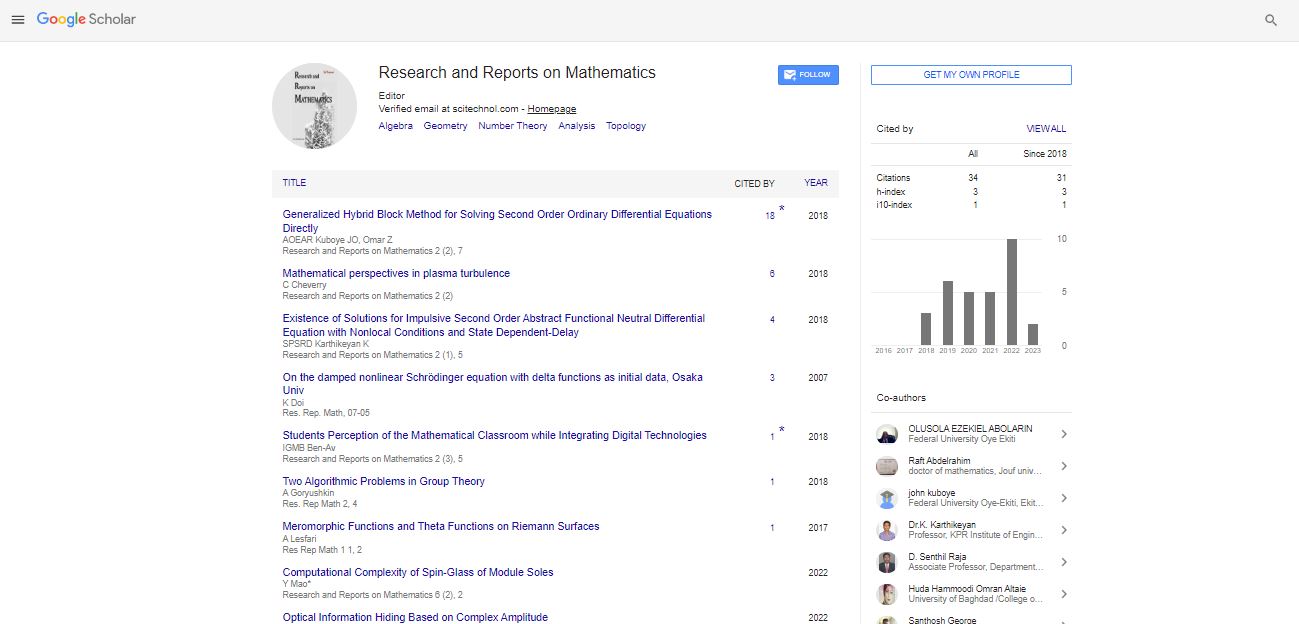Short Communication, Res Rep Math Vol: 2 Issue: 3
Geometric Proof of the Sum of Geometric Series
Korus P*
Department of Mathematics, Juhasz Gyula Faculty of Education University of Szeged, Hungary
*Corresponding Author : Korus P
Department of Mathematics, Juhasz Gyula Faculty of Education University of Szeged, Hattyas utca 10, H-6725 Szeged, Hungary
E-mail: korpet@jgypk.u-szeged.hu
Received: March 28, 2018 Accepted: July 10, 2018 Published: September 8, 2018
Citation: Korus P (2018) Geometric Proof of the Sum of Geometric Series. Res Rep Math 2:3
Abstract
The well-known formula for the sum of the geometric series is For arbitrary -1<q<1. Among analytic proofs, geometric proofs were also given for this formula, see [1], mostly for 0<q<1. Now we prove that for any 0<q<1
Keywords: Algebra, Applied Mathematics, Arithmetic, Calculus, Combinatorics, Computational Mathematics, Geometry & Topology
Introduction
The well-known formula for the sum of the geometric series is

For arbitrary -1<q<1. Among analytic proofs, geometric proofs were also given for this formula, see [1], mostly for 0<q<1. Now we prove that for any 0<q<1

holds in the ‘Positive case’ and

in the ‘Alternating case’.
Positive case
As in Figure 1, we do the following process.
Step 1: Take a unit square S1 and take rectangles Q1 with area  = q and Q2 with
= q and Q2 with  = q2. We also take ‘adjunct’ rectangles R1 with
= q2. We also take ‘adjunct’ rectangles R1 with  and R2 with
and R2 with 
We get a remaining square S2 of side length q.
Step 2: We repeat the actions of the previous step for S2, but we reduce the rectangles by a scale factor of q. Then we get Q3; Q4; R3; R4 with  and a remaining square S3 of side length q2.
and a remaining square S3 of side length q2.
General step k: We repeat the actions of the previous step for Sk, but we reduce the rectangles by a scale factor of q.
We get that the area of unit square S1 is

Hence 
Alternating case
As in Figure 2, we do the following process.
Step 1: Take a unit square S and take rectangles Q1+ with AQ1+ = q and Q2− with AQ2- = q2. We also take ‘adjunct’ square R1+ of side length 1 with  and rectangle R1- of side lengths q and 1 with
and rectangle R1- of side lengths q and 1 with  (Plus and minus signs indicate the signs of the areas of rectangles within the final sum.)
(Plus and minus signs indicate the signs of the areas of rectangles within the final sum.)
Step 2: We repeat the actions of the previous step for square Q2− of side length q, but we reduce the rectangles by a scale factor of q. Then we get  with
with  ,
, 
General step k: We repeat the actions of the previous step for Q2k-2− , but we reduce the rectangles by a scale factor of q.
We get that the area of unit square  is
is

Hence 
References
- Nelsen RB (1993) Proofs without words: Exercises in visual thinking. MAA.
 Spanish
Spanish  Chinese
Chinese  Russian
Russian  German
German  French
French  Japanese
Japanese  Portuguese
Portuguese  Hindi
Hindi 

